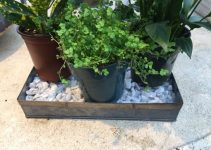Learning objectives
After reading this article, you’ll learn:
- Benefits of houseplants to clean the air indoors.
- Know some indoor houseplants.
- Learn about Beneficial Houseplants that can clean air.

Do you know that houseplants are not only used to beautify your home but also help in improving air quality? Even though it is known that plants release oxygen, they also help by purifying the air. Research studies on several occasions found that indoor houseplants help to clean the air in homes that had them. Scientists at NASA, who are credited with the findings, carried them in the 1970s to Skylab Space Station. There, a particular plant helped to eliminate toxic chemical fumes from synthetic material at the station. The humidity level present in the atmosphere also improved, which helps eliminate dry air as a result of your heating or air conditioning unit.
Common Indoor Air Pollutants
It is not only outdoors were air pollutants exist. Air pollutants are also present indoors sometimes. This may expose you to toxic air that can be hazardous to your healthy living. Before the 1970s when the benefits of air plants were discovered, building standards were improved. The discovery that it is beneficial to have air-tight homes and structures insulated them. Having an air-tight standard in buildings helps to conserve more energy since it’s more efficient to heat or cool the area.
However, older buildings with drafty windows have their benefits, too, since these facilitate circulation of air while bringing in the fresher air to breathe.
Synthetic materials are always involved in off-gassing processes. This means that chemicals or toxic fumes are emitted into the air as these material are used. Among these items known for generating and emitting poisonous substances into the atmosphere include plastic, TVs, computers, and also construction materials. Chemicals like ammonia, Toluene, formaldehyde, and benzene are among these harmful substances that are made from synthetic products.
When these toxins are breathed, different health problems may arise. These health problems include fatigue, skin irritation, respiratory problems and poor concentration. Therefore, it’s best to remove these substances that negatively affect the body, particularly synthetic and chemically subjected items used within indoor dwelling spaces.
How Some Plants Can Help?
Considering the potential problems on human health that some materials can induce, it is a good idea to find a natural and an effective way to get rid of these. One of the quick solutions is by growing houseplants that are known to improve indoor air freshness. These plants eliminate toxins while enhancing the look and atmosphere in your living space. Also, since houseplants are not costly, you can easily add some to your living space and improve the freshness of the air you breathe. They are desirable in some places commonly known to have toxins.
Chrysanthemum morifolium and Peace Lily are wonderful houseplants tested to get rid of toxic fumes. Additionally, the popular indoor tropical evergreen plants like deciduous plants (in the likes of the Mums) are also a good alternative since these can also clean the air. Just bear in mind that these houseplants only blossom during the cooler seasons. This means you can’t expect them to stay in perfect indoor condition when there is a rise in temperatures. But, you can help them do well at this time by humidifying your home to keep them in bloom until the cooler months come.
Below are some other plants that make the air you breathe cleaner, fresher and healthier.
1. Peace Lily
The Peace Lily is an indoor houseplant and usually does well during the springtime. The Lily has an attractive look and strong air purifying power. In addition to releasing oxygen, these houseplants assimilate toxic substances such as ammonia, trichloroethylene, xylene, toluene, benzene, and formaldehyde.
In order to care for the peace lily plants, it is best to mount the plants in low-light conditions a bit far from the window location. When exposed to too much sunlight, it will cause the plants to wilt or have brown leaves with yellow streaked edges. Ensure to water it heavily at least once every week and make it a routine to clean its leaves whenever you notice dust accumulating on it. It is also advised to keep these plants far away from drafts.
2. Snake Plant
It is never difficult to grow snake plants. All you need to do is water regularly once a week and expose to sunlight. And if you notice the leaves getting pale green, it means it’s getting too exposed to sunlight. Try as much as possible to clean its leaves often due to dust accumulation. Keep nourishing with some fertilizer in summer and spring months.
When it comes to air cleaning ability, some of the chemicals the snake plant can remove include ammonia, toluene, benzene, xylene, formaldehyde, and trichloroethylene. Since it is not difficult to care for the plant, the snake houseplant should be a perfect solution for those with busy schedules.
3. Dracaena Deremensis Janet Craig
Since this plant is a vine, you can plant a sturdy stake in the center of the pot and then leave the plants to grow upwards. It is recommended to position this plant in a low surrounding and water it once every week to make it healthy.
The Janet Craig is a popular houseplant that will help you clean your indoor air. Basically, it’s a corn plant, and it’s very good at filtering toxic fumes and chemicals present in the home air including benzene, toluene, and formaldehyde. It is nice having the plant in your office or home to maintain freshness of your indoor air.
The Janet Craig plants grow up to 10 feet and have lush green and thick leaves. Once it starts to bring out flowers, you will notice its aroma, which will improve the air in your room. It is good to place the Janet Craig plants closer to sunlight even though not under it directly. During warm months, some liquid fertilizers can also help to boost its health and growth.
4. Golden Pathos
The Golden Pathos is commonly called the Devils Ivy. These houseplants help to get rid of harmful and poisonous fumes that move in our home air, which makes it ideal for indoor usage. It has heart-shaped leaves, which are appealing and act as a decoration.
5. Dracaena Warneckii
The Dracaena Warneckii also works adequately in air purification. Its leaves look closely to that of the Janet Craig’s plant, but the Dracaena plant has sharply pointed leaves with lighter shades of green. Also, it has a 6 feet maximum height when fully matured and survives when planted in areas with artificial or dim light conditions.
Final words
Houseplants not only act as decorative to the home but also have air-purifying actions to clean the air indoors. Having one today will be beneficial to your healthy living and aromatic atmosphere indoor. It does not cost much to buy houseplants to clean your air. They’re also easy to care for and maintain.
Remember, most houseplants don’t bloom during the normal temperature months, so keep your plants healthy at all times. You can keep your home moisture level normal by humidifying your home using a good humidifier to add moisture to the air to keep the plants in good health.



